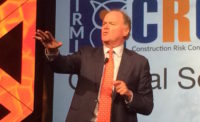
Fluor Corp.’s international portfolio and financial might would seem to dictate a conservative approach to design and construction. Few would be surprised, for example, if the company abided by the familiar concept that every project risk ought to be commensurate with potential reward.
As it happens, that isn’t how Fluor practices risk management, said Paul Bruno, the company’s managing general counsel. And he wants to dispel the old idea that risk should always equal reward.
“If it can be identified, managed and mitigated, any risk can be tolerated,” he said.
Exactly how Fluor does that was the subject of Bruno’s keynote address at ENR’s 3rd Risk Summit, in Dallas at the Marriott Los Colinas June 16.
It’s hard not to take Fluor seriously on the subject. Despite the decline in energy prices, Fluor continues to post solid financial results. The company reported net income of $720.74 million (available per common share) on revenue of $20.7 billion in 2014.
Bruno started by dispelling the big myth of risk equaling reward. “Everyone makes the assumption that if the reward is sufficient, then it’s worth taking the risk,” he said.
That idea, he said, is often tied up with the concept of monetizing risks, such as putting a bigger contingency in a bid because skilled labor is short for a prospective new project. And when applied to worker safety such simplistic assumptions can lead to absurdities, about whether a very hazardous project or type of work should be undertaken, or to trying to assign a value to a human life.
Monetizing personal injury risk should be avoided at all costs, he said.
Instead, Bruno said, Fluor follows a process developed in the wake of the company’s financial turmoil the late 1990s. In 2001 Fluor formalized the process and called it the company’s business risk management framework (BRMF). It calls for Fluor to identify, measure, mitigate and manage all the risks on every project.
Monitoring Risks
After the risks are identified, Fluor assigns each a probability determined using typical a Monte Carlo method analysis. The risk-mitigation strategy is then designed.
But then how do you monitor risk during execution? Bruno asked.
A key part of the framework involves keeping the project executive or project manager in regular contact with the project transactional attorney—the attorney most familiar with the project contract, or at smaller companies, the person who negotiated the terms— in touch so that they can interpret the contract.
“They (the transactions attorneys) are the best interpreters (of the contract) in terms of risk,” he said. “Keep them engaged.”
Fluor makes sure the project executive or a key manager speaks to the project transactionallawyer at least once a month; a key to managing and implements risk mitigation strategies and avoiding surprises for top management. By requiring regular communication, which can be built into a process and measured, Bruno said, human nature assures that it will get done.
That way, Bruno said, potentially high-impact events with time-limits for notice, “something as simple as a notification of delay,” can be promptly dealt with.
The risk control system will help win a better premium when buying coverage from insurers—an important final step in a process when part of the risk is monetized. Insurers “will appreciate the processes and procedures you have in place and that will be reflected in the premium you are charged,” Bruno said.
Payment and Schedule
In addition to dispelling the simple idea of risk always equaling reward, Bruno said he is not a fan of some other common ideas about risk shifting via insurance and payment-related contract clauses.
The idea of shifting risk, he said, is not in and of itself wrong or destructive to the project fabric. “There’s nothing evil about this,” he said. “Once you identify what can be monetized or mitigated, and get everyone together to discuss these processes, and see where things fall out from the mitigated risk, the time has come to talk to an attorney about proper contract language.”
“Reading the contract can identify what can and can’t be shifted, and that helps in the decision-making process.”
Bruno said he isn’t a big fan of additional-insured clauses incorporated in many prime contract agreements.
Such clauses, while potentially helpful in tendering the costs of defense in a lawsuit, breed potential conflicts about strategy among defendants. Some who see benefit in settling a lawsuit will want to pursue that goal, while another company, possibly one concerned about its reputation, could decide it is best in the long-run to fight a claim.
Most risk-shifting, said Bruno, isn’t in the payment terms, although it certainly occurs there, but in the schedule-related and indemnity sections of a contract.
In particular, owners shift risk via clauses concerning sharing of schedule float that allow the owner to claim float in the schedule. “So pay close attention to the schedule clauses. Who controls the critical path? How often is the schedule updated?”
“That’s a hot one for many contractors.”
Fluor applies its business risk management framework no matter what kind of project it is building.
“You can make decisions based on what kind of project there is and as to whether you will accept more risk or not, or whether to get more coverage or a higher or lower self-insured retention,” but the basic-risk-identification and management process should not be different.
The basic goal is always the same: avoid bringing top managers surprises because “surprises are rarely a good thing.”




Post a comment to this article
Report Abusive Comment